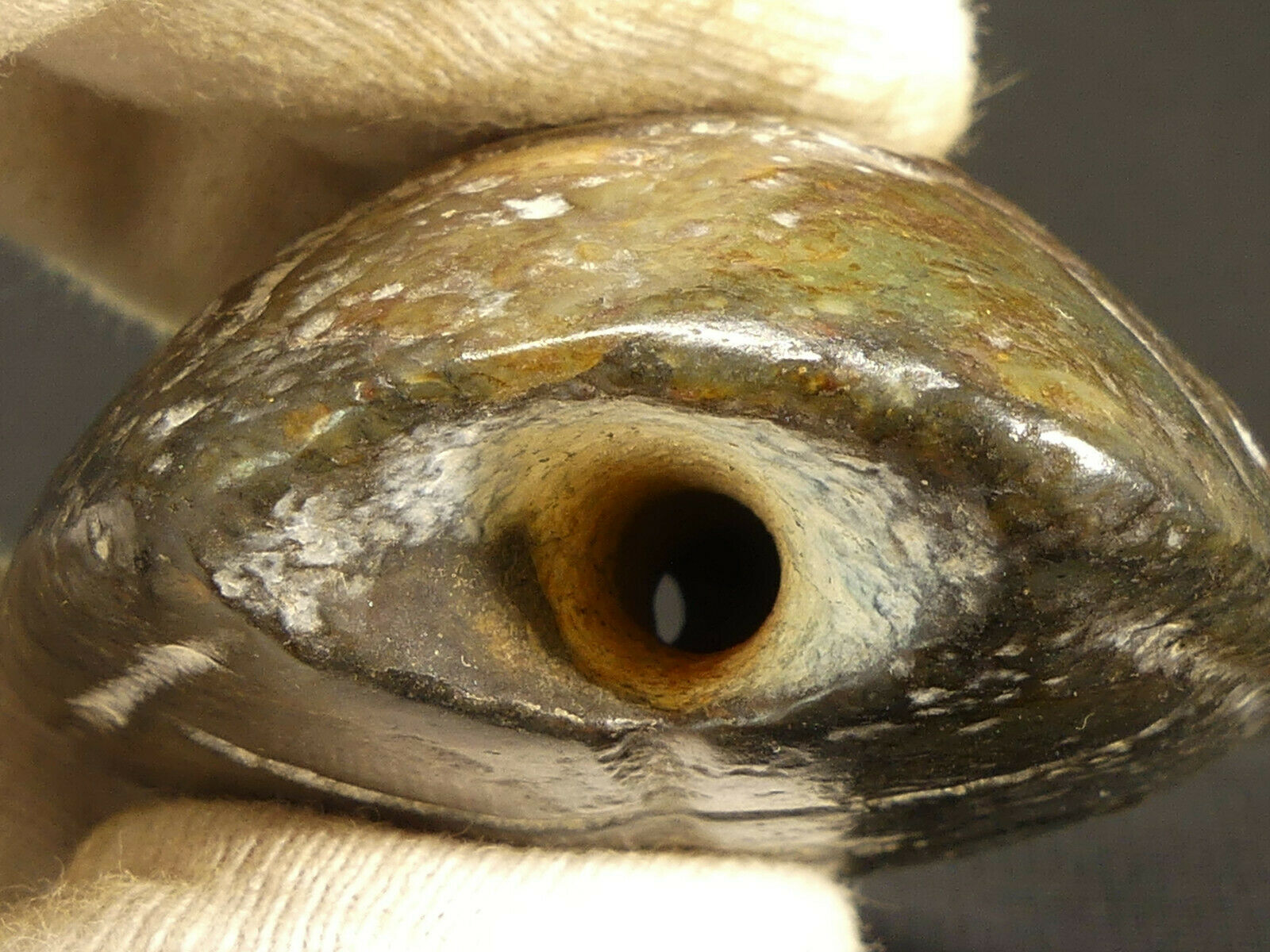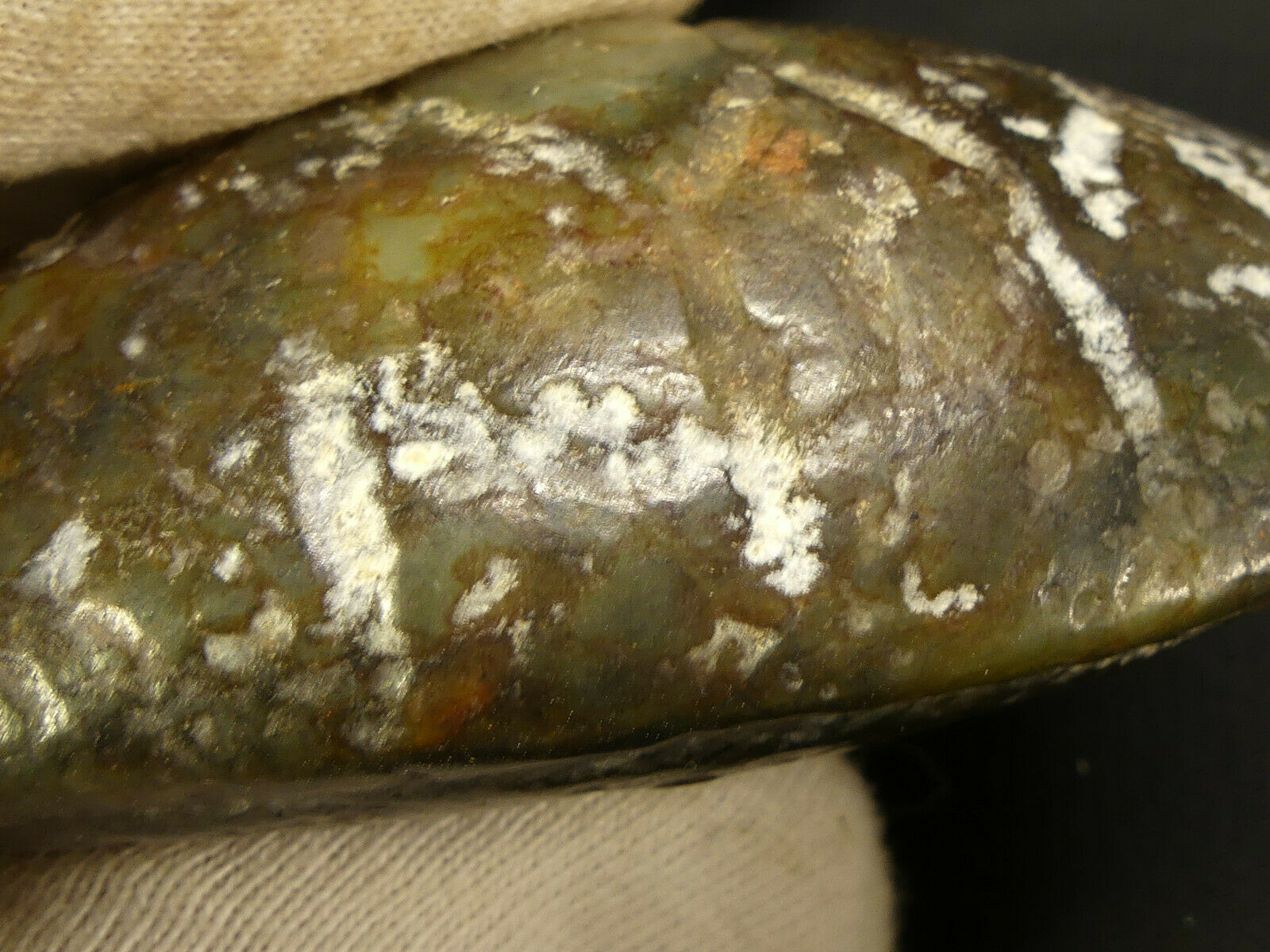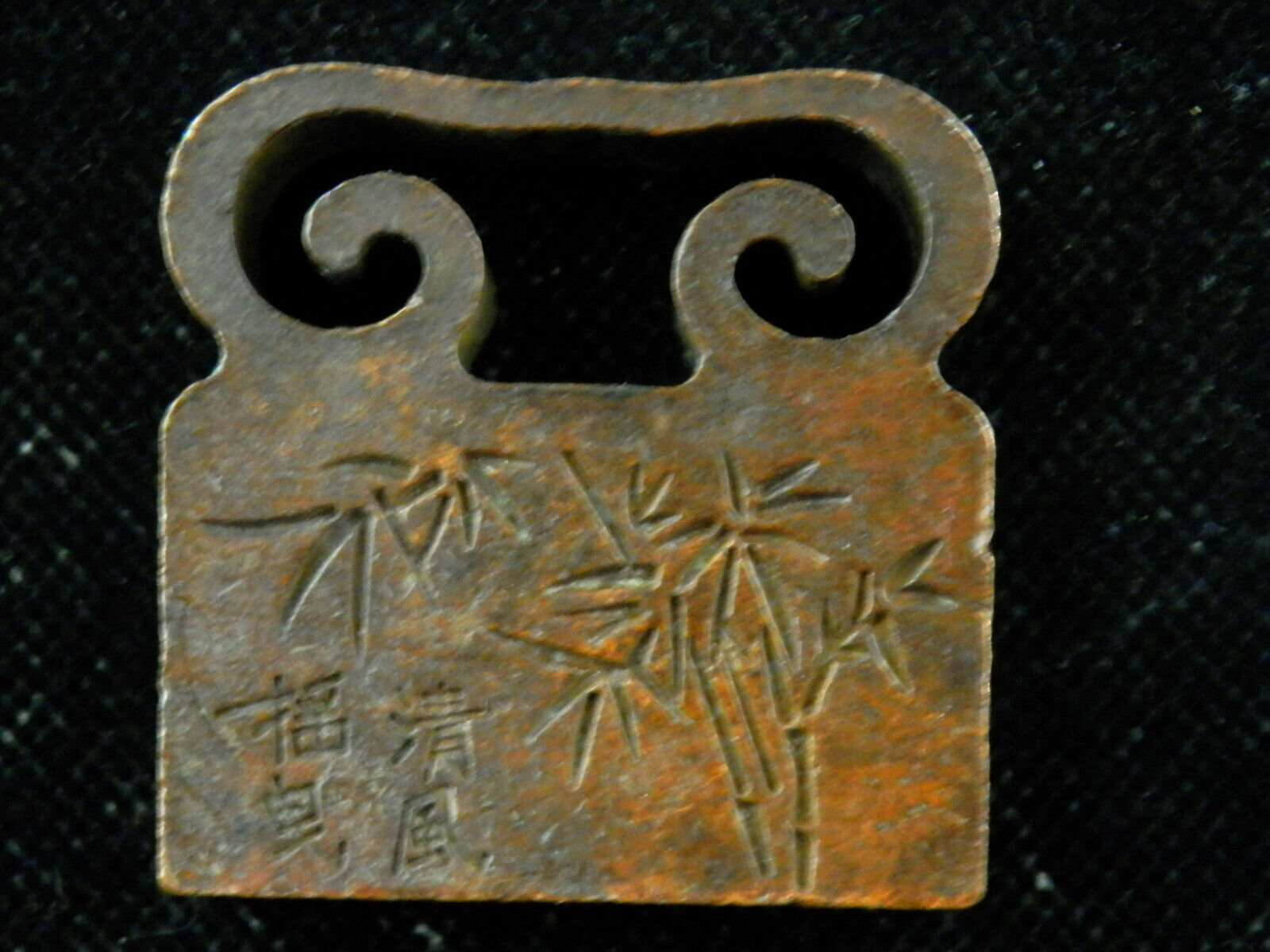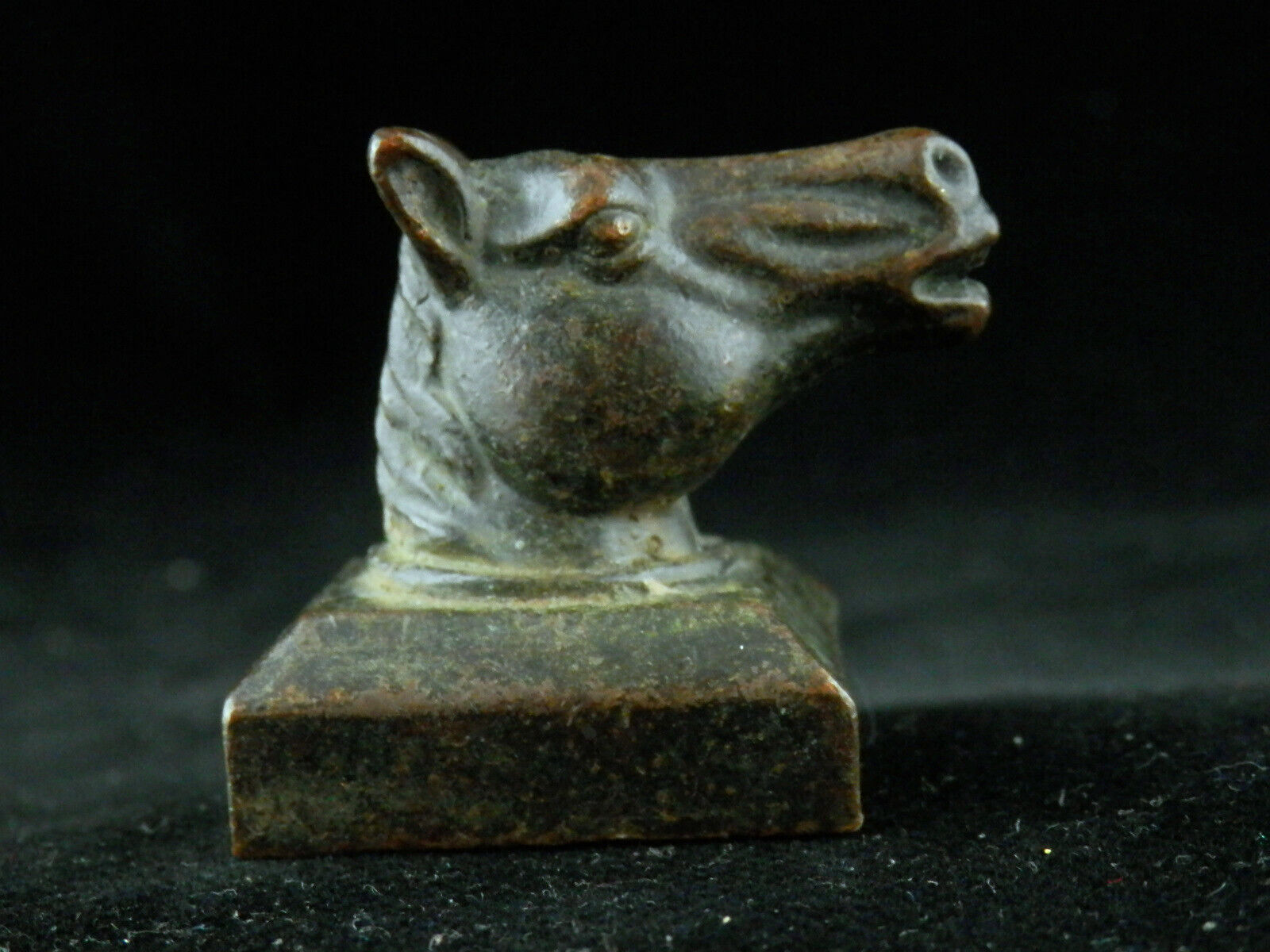-40%
Chinese Hongshan Culture Jade Tortoise/Turtle Shell Amulet II w/Translation
$ 617.75
- Description
- Size Guide
Description
Ancient CivilizationsAntiques, Artifacts & Fine Collectables
Ancient Chinese Jade Tortoise Shell Amulet II
With English Translation of Pictographic Characters
Imperial Fire-Breathing Dragon & Ritual Offerings
Hongshan Culture
4500 BCE—2250 BCE
NOTE:
William Houghton, the President of ANCIENT CIVILIZATIONS
, a State of Washington Licensed Business, assumes all responsibility for the information contained in this description and for the English translation and transcription of the ancient Chinese graphic characters.
Furthermore, I prohibit the further dissemination of this information in any written, video, or electronic format without my expressed, written approval.
Thank You!
SUMMARY
Item:
Chinese Jade Tortoise Shell Amulet
II
Material:
Olive green Nephrite jade, with an estimated 10+ pictograms incised and percussively pecked into the jade amulet.
Culture:
Hongshan Culture, China
Date:
4500 BCE—2200 BCE
Measurements:
·
Height:
1.13” (29mm)
·
Width:
2.63” (67mm)
·
Depth:
1.12” (29mm)
·
Weight:
4.3.oz. (122gr.)
Condition:
This nephrite jade, Hongshan Culture amulet is in very good condition with no repairs or restorations.
The olive-green jade has some orange/brown highlights from the iron, micro-crystalline jade, and other elements in the damp soil that have been absorbed into the jade after being buried for thousands of years.
This patina should never be removed, because the natural patina is one way to identify an authentic Liangzhu jade.
It has moderate to heavy mineral deposits and pitting from differential weathering.
Provenance: This amulet/pendant/plaque is one of several pendants that were obtained from a private collector in China.
These items were first purchased by the private collector’s father in approximately 1998 from an old private collection in China in Zhejiang Province, China. I believe these pendants would have been included in an Emperor’s tomb or temple to provide him a safe journey and eternal life in Heaven.
These pendants have for many years been in this author’s private collection in the State of Washington.
This is the first time it has been offered for sale in the United States.
Percussively pecked on the front and back of the pendant are Imperial Dragons and the character “
Wang
” for King/Emperor.
These pictographs verify that this man was the Emperor or at a minimum held a high-level position in the Emperor’s court or his family, as no ordinary old man or woman would have dared to have an Imperial Dragon on a piece of jade that would have been placed in a tomb or in his or her temple.
NOTE:
These items offered for sale by Ancient Civilizations are unconditionally guaranteed authentic. They were legally imported to the United States years ago and are legal to sell and own under U.S. Statute Title 19, Chapter 14, Code 2611, Convention on Cultural Property.
DETAILS
This lovely jade pendant dates to the Neolithic Chinese people known as the Hongshan Culture (4500 BC—2250 BC.)
The Hongshan are believed to have been one of the first people in China to ever use jade as a marker of social status—and this jade pendant has the pecked image of a several, Fire-Breathing Dragons that served as a protective amulet against Evil Spirits that could prevent the man’s soul from reaching immortality in Heaven.
At each end of the amulet is a suspension hole that runs the length of the tortoise shell and that is classified by the experts as a “ox-nose loop” hole, as it curves around.
The inside edges of the holes contain micro-crystalline, white jade and red iron particles that can only form on worked jade that is over 2,000-years-old.
These crystals, which are also evident in the cut lines on the jade tortoise, are very fragile and should never be removed as they confirm that this amulet is ancient.
{See macro photos # 5-8}
English Translation of Early Chinese Written Words/Characters (Pictographs)
NOTE:
William D. Houghton, the President of ANCIENT CIVILIZATIONS, a State of Washington Licensed Business, assumes all responsibility for the information contained in this description and for the English translation and transcription of the ancient Chinese graphic characters.
Any translation errors are unintentional and strictly mine.
This 5,000-year-old ritual jade amulet contains several pictographs and characters that have been incised and percussively pecked into the jade tortoise.
These pictographic characters on ritual and tomb jades are the earliest form of a written language in ancient China.
Modern archeologists call these early pictograms “Small Seal Script” as they have been found as a permanent record that was written by scribes on both oracle bones of cattle and on ritual jade artifacts.
Although many of the characters are very faint or partially covered by oxidation, here are some of the words I’ve translated:
1.
As noted above, on the underside of the of the jade tortoise shell, is the compound character “
Wang
” that means King or Emperor.
It is composed of three parallel lines that is the ancient character “
San
” that means “Heaven, Earth, and Mankind” and the single vertical line represents the Emperor.
These are all the things that are ruled over by the Supreme Heaven God
Di
and it is
Di
who is the Father of all Chinese Emperors that are entrusted with ruling all things on Earth.
{See macro photos # 1 & 4}
2.
The Sons and Grandsons offering the traditional items of jade, ritual wine, and sacrificed animals to the Ancestors.
{See macro photo # 9 inside the red square.}
3.
A Fire-Breathing Dragon to scare away Evil Spirits.
4.
A Heaven Bird carrying the Soul of the departed Father to Heaven (Tien).
5.
Ancestors diving towards immortality in Heaven that is symbolized by the center hole in the amulet. Several other very small character, some only 2mm long, that were only meant to be seen by the Ancestors, as human eyes were not worthy.
{See macro photos # 8 inside the blue circle. }
6.
The Son offering strings of money (called cowrie shells) to the Ancestors.
{See macro photo # 10}
7.
Several other pictographs that are indecipherable.
The Tortoise in Chinese History
In China the traditional Chinese character symbolizing the turtle (
龜
) shows a head like that of a snake at the top, to the middle left of the paws, to the middle right of the shell, and at the bottom of the tail. According to the "
Book of Ceremonies
", the white tiger, phoenix, tortoise, and dragon are the four entities that possess spirit. Tortoise shells were used for divination during the ancient Chinese Shang Dynasty and carry the earliest specimens of Chinese writing. Some Chinese are of the opinion that their script was taken from the signs on the back of the tortoise.
For the Chinese, the tortoise is sacred and symbolizes longevity, power, and tenacity. It is said that the tortoise helped
Pangu
(also known as
P'an Ku
) create the world: the creator goddess
Nuwa
or
Nugua
cuts the legs off a sea turtle and uses them to prop up the sky after Gong Gong destroys the mountain that had supported the sky. The flat plastron and domed carapace of a turtle parallel the ancient Chinese idea of a flat earth and domed sky. For the Chinese as well as the Indians, the tortoise symbolizes the universe.
The tortoise is one of the "Four Fabulous Animals", the most prominent beasts of China. These animals govern the four points of the compass, with the Black Tortoise the ruler of the north, symbolizing endurance, strength, and longevity. The tortoise and the tiger are the only real animals of the four, although the tortoise is depicted with supernatural features such as dragon ears, flaming tentacles at its shoulders and hips, and a long hairy tail representing seaweed and the growth of plant parasites found on older tortoise shells that flow behind the tortoise as it swims. The Chinese believe that tortoises come out in the spring when they change their shells, and hibernate during the winter, which is the reason for their long life.
The Chinese Imperial Army carried flags with images of dragons and tortoises as symbols of unparalleled power and inaccessibility, as these animals fought with each other, but both remained alive. The dragon cannot break the tortoise and the latter cannot reach the dragon. In China, the tortoise was also called the Black warrior, standing as a symbol of power, tenacity, and longevity, as well as that of north and winter. A tortoise was often put at the base of burial monuments.
Legend holds that the wooden columns of the Temple of Heaven in Beijing were built on the shells of live tortoises since people thought that these animals were capable of living for more than 3,000 years without food or water and are adorned with a magical power that prevents wood from rotting. It was considered that the tortoise does not remember the day and month of its birth, so calling someone a "tortoise" in China was considered offensive.
The tortoise is of the
feng shui
water element with the tiger, phoenix, and dragon representing the other three elements. According to the principles of
feng shui
the rear of the home is represented by the Black Tortoise, which signifies support for home, family life, and personal relationships. A tortoise at the back door of a house or in the backyard by a pond is said to attract good fortune and many blessings. Three tortoises stacked on top of each other represent a mother and her babies. In Daoist art, the tortoise is an emblem of the triad of earth-humankind-heaven.
The tortoise is a symbol of longevity, with a potential lifespan of ten thousand years. Due to its longevity, a symbol of a turtle was often used during burials. A burial mound might be shaped like a turtle, and even called a "grave turtle." A carved turtle, known as
bixi
was used as a plinth for memorial tablets of high-ranking officials during the Sui Dynasty (581-618 CE) and the Ming periods (1368-1644 CE). Enormous turtles supported the memorial tablets of Chinese emperors and support the Kangxi Emperor's stele near Marco Polo Bridge in Beijing, China. Tortoise shells were used for witchcraft and future forecasting. There are innumerable tales on the longevity of the tortoises and their ability to transform into other forms.
REFERENCES:
The Great Bronze Age of China
:
An Exhibition from the People’s Republic of China
, edited by Wen Fong, 1980
Metropolitan Museum of Art, 1980.
Ancient Chinese Warfare
, Ralph D. Sawyer, Mei-chün Sawyer
Archaeology
, Archaeological Institute of America, Feb/March 2015
Shanghai Museum
British Museum
Museum of Chinese History, Beijing
British Museum
Smithsonian Museum, Sackler & Freer Gallery, WDC
MET, New York
Please ask any questions you may have before you bid!
Please examine the photos carefully, as they are an important part of the description.
The stand is not included, just there to help you judge the size.
Per e-Bay's rules, PayPal only please! All Sales are Final!
THANKS!
FREE SHIPPING cost includes Insurance and is accurate for all 50 United States.
International buyers are responsible for all shipping costs, full insurance, and any import taxes or duties. Thank You!




















